|
Tattoo Symbol Index - A
B
C
D
E
F
G
H
I
J
K
L
M
N
O
P
Q
R
S
T
U
V
W
X
Y
Z
MILITARY TATTOOS and SYMBOLS of MEMORIAL
and PROTECTION
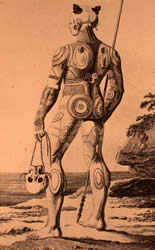 Like tattoos with spiritual and religious symbolism, military
tattoos often have a strong element of the amulet or talisman
connected to them. Protection in battle was often a specific
requirement of tattoos acquired in many cultures and the tattoo was
accompanied with rituals, incantations, and pigment which was
believed to have special or magical properties. Tattooing was
carried out by Shamans, medicine men, priests and other individuals
who were known to have access to special powers. These properties
might render an individual invisible or impervious to the weapons of
opponents. A tattoo in this instance was meant to act as a shield
and a final line of personal defense. This is still a belief in
places like Burma, Thailand and other areas. Like tattoos with spiritual and religious symbolism, military
tattoos often have a strong element of the amulet or talisman
connected to them. Protection in battle was often a specific
requirement of tattoos acquired in many cultures and the tattoo was
accompanied with rituals, incantations, and pigment which was
believed to have special or magical properties. Tattooing was
carried out by Shamans, medicine men, priests and other individuals
who were known to have access to special powers. These properties
might render an individual invisible or impervious to the weapons of
opponents. A tattoo in this instance was meant to act as a shield
and a final line of personal defense. This is still a belief in
places like Burma, Thailand and other areas.
|
|
In many early cultures members of warrior castes were identified
with tattoos and other identifying marks. The tattoo on a soldier
was as much an identifying mark as a uniform. Greek and Roman
historians specifically mention many tribes whose soldiers were
heavily marked with tattoos, including the Picts in Great Britain,
Thracians, Scythians and many members of the Gaul and Germanic
tribes. Early explorers to North America remarked that the natives
were heavily tattooed, and that tattooing and body paint rituals
were important preparations for battle. |
In cultures where an individual's life history was represented in
their body art, tattoos were a way for individual to display their
prowess in battle. The Maori marked their personal military
histories with tattoos and for an Iban headhunter, every head taken
was marked with special tattoos on the hands. For an Iban warrior,
tattoos that showed prowess in battle had connotations for the
afterlife. For the Iban and other cultures, being heavily tattooed
made it a greater likelihood that deceased individuals would
successfully navigate their way into the Spirit World or After Life.
In many cultures individuals must make their way after death over a
river, a barrier of some sort or through a gateway. It is not
uncommon for this journey to be a perilous one, or for there to be
gatekeepers whose role it is to keep out unworthy individuals. A man
who was heavily tattooed would find it easier to make this journey.
Tattoos that fulfilled this task were seen to be as important in
death as they were in life.
For other soldiers, specific tattoos that represented a religious
affiliation would ensure that if they fell in battle, they would
receive a proper burial.
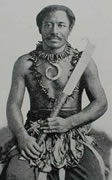 An investigation into the modern history of military tattoos
leads invariably to the South Pacific in the year 1768. We find the
English Sea Captain, James Cook commanding his first expedition in
the ship Endeavor. Cook and his crew sailed to Tahiti with a
scientific contingent to study an eclipse. Three months later they
sailed home to Europe, many of them - both Officers and ordinary
Seamen - with tattoos, a tradition among sailors that is still
practiced to this day. History cites earlier European merchant
mariners landing on Polynesian islands and witnessing with equal
astonishment the tattoo culture of the South Seas, but there's no
record of those earlier sailors bringing tattoos home as souvenirs
of their journey. An investigation into the modern history of military tattoos
leads invariably to the South Pacific in the year 1768. We find the
English Sea Captain, James Cook commanding his first expedition in
the ship Endeavor. Cook and his crew sailed to Tahiti with a
scientific contingent to study an eclipse. Three months later they
sailed home to Europe, many of them - both Officers and ordinary
Seamen - with tattoos, a tradition among sailors that is still
practiced to this day. History cites earlier European merchant
mariners landing on Polynesian islands and witnessing with equal
astonishment the tattoo culture of the South Seas, but there's no
record of those earlier sailors bringing tattoos home as souvenirs
of their journey.
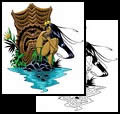 In Hawaii and the Marquesas Islands, Cook encountered an
indigenous tattoo worn only by the warrior class, and which served a
truly military purpose. Tattoo as camouflage. The warrior's body was
fully tattooed, but on one side only. This half-body tattoo would be
presented to the enemy in combat. Presumably, this left him with a
clean side to present in civilian, domestic and perhaps even
romantic affairs. In Hawaii and the Marquesas Islands, Cook encountered an
indigenous tattoo worn only by the warrior class, and which served a
truly military purpose. Tattoo as camouflage. The warrior's body was
fully tattooed, but on one side only. This half-body tattoo would be
presented to the enemy in combat. Presumably, this left him with a
clean side to present in civilian, domestic and perhaps even
romantic affairs.
By the beginning of the 19th century, as more and more sailors
returned from distant lands, the tattooing had become highly popular
in the British Navy. It spread even to the British admiralty, which
has for a long time included certain royals who obtained rank. Field
Marshal Earl Roberts is rumored to have
 expressed the opinion that
"every officer in the British army should be tattooed with his
regimental crest." It not only boosted morale among the ranks, but
it proved useful when identifying casualties. The Prince of Wales
was tattooed with a Jerusalem Cross after visiting the Holy Land in
1862. Then, his sons, the Duke of Clarence and the Duke of York
(later King George V) were tattooed by the Japanese master
tattooist, Hori Chiyo. expressed the opinion that
"every officer in the British army should be tattooed with his
regimental crest." It not only boosted morale among the ranks, but
it proved useful when identifying casualties. The Prince of Wales
was tattooed with a Jerusalem Cross after visiting the Holy Land in
1862. Then, his sons, the Duke of Clarence and the Duke of York
(later King George V) were tattooed by the Japanese master
tattooist, Hori Chiyo.
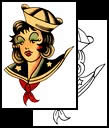 Although much of maritime tattooing took place on board ship,
sailor to sailor, the craze spawned an industry of tattoo parlors in
port cities in Britain and the United States, and indeed, around the
world. Many of the proprietors of early tattoo shops were sailors
who had come ashore. Famed British tattoo artist George Burchett
learned his craft with an early stint in the service. By the end of
the 19th century, it was estimated that ninety percent of British
and American sailors had tattoos, according to some sources. Although much of maritime tattooing took place on board ship,
sailor to sailor, the craze spawned an industry of tattoo parlors in
port cities in Britain and the United States, and indeed, around the
world. Many of the proprietors of early tattoo shops were sailors
who had come ashore. Famed British tattoo artist George Burchett
learned his craft with an early stint in the service. By the end of
the 19th century, it was estimated that ninety percent of British
and American sailors had tattoos, according to some sources.
If the voyages of Captain Cook are to be credited with
re-introducing the tattoo to the Western World, it's thanks in part
to a cultural amnesia that left the vast majority of Europeans
ignorant of their own tattoo history. The earliest physical evidence
of a tattoo on human skin, for instance, was found in the Alps of
northern Italy, on a corpse that had been frozen into the glacier
for 5,300 years. Ötzi the Ice Man was amazingly well-preserved, as
were his fifty-three tattoos. Was he a soldier? Perhaps not, but if
any of his many tattoos symbolized his membership in a warrior clan,
then we have traced the military tattoo back to the early Bronze
Age.
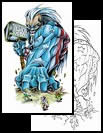 Jumping ahead 2500 years, we find the Britons heavily engaged in
the practice of inking their skin. Roman historians recorded that
the Picts used 'woad', a blue dye extracted from the plant, isatis
tinctoria, (chemically identical to indigo, the color of our blue
jeans) in their body art. It is most probable that the Picts used
woad for pigment for external body painting and some form of
carbon-based pigment for tattoos. Modern attempts to tattoo with
woad have not been successful. The armies of Julius Caesar testified
to being 'horrified' at the appearance of the Britons when facing
them in battle. Of course, the native warriors in Briton were also
likely to have sported lime-washed hair styled in the manner of a
horse's mane, and have been nearly or fully naked with all his many
scars in full display. The intent was clearly to intimidate the
enemy, and the woad dye would certainly have added to that effect. Jumping ahead 2500 years, we find the Britons heavily engaged in
the practice of inking their skin. Roman historians recorded that
the Picts used 'woad', a blue dye extracted from the plant, isatis
tinctoria, (chemically identical to indigo, the color of our blue
jeans) in their body art. It is most probable that the Picts used
woad for pigment for external body painting and some form of
carbon-based pigment for tattoos. Modern attempts to tattoo with
woad have not been successful. The armies of Julius Caesar testified
to being 'horrified' at the appearance of the Britons when facing
them in battle. Of course, the native warriors in Briton were also
likely to have sported lime-washed hair styled in the manner of a
horse's mane, and have been nearly or fully naked with all his many
scars in full display. The intent was clearly to intimidate the
enemy, and the woad dye would certainly have added to that effect.
In the 6th century A.D., the Roman physician, Aetius, provides
evidence of the cult of the military tattoo in ancient times. He
published Medicae artis principes, in which he defines the term
'stigmates' as "...marks that are made on the face and other parts
of the body. We see such marks on the hands of soldiers." We know,
too, that tattoos of the Roman era were a punitive measure, to
identify convicts. The Roman army applied a similar strategy when
its ranks were comprised mainly of mercenaries. According to C.P.
Jones (in an article titled, "Stigma: Tattooing and Branding in
Graeco-Roman Antiquity") the mercenaries were tattooed so that
deserters could be identified.
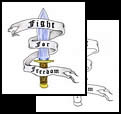 Warrior or convict, the tattoo has the effect of transforming the
person to some degree. When a person receives a tattoo to signify
membership in a group, the shared pain acts as the all-important
shared experience that gives rise to esprit de corps. Note that it's
not the 'esprit de Mike or Joe or Jane', it's the fighting spirit of
the whole unit that wins battles. Strong morale within the ranks
breeds a belief in the goal, in your comrades, and in yourself. The
rituals that accompanied getting a tattoo would be important lessons
for young recruits, the ability to withstand pain with stoicism, the
shedding of blood, and a profound sense of belonging to an
enterprise larger than yourself. These experiences are universal and
nearly all military or warrior cultures around the world have some
element of ritual that is as common as boot camp - which is often
when military service personnel get their first tattoo. Warrior or convict, the tattoo has the effect of transforming the
person to some degree. When a person receives a tattoo to signify
membership in a group, the shared pain acts as the all-important
shared experience that gives rise to esprit de corps. Note that it's
not the 'esprit de Mike or Joe or Jane', it's the fighting spirit of
the whole unit that wins battles. Strong morale within the ranks
breeds a belief in the goal, in your comrades, and in yourself. The
rituals that accompanied getting a tattoo would be important lessons
for young recruits, the ability to withstand pain with stoicism, the
shedding of blood, and a profound sense of belonging to an
enterprise larger than yourself. These experiences are universal and
nearly all military or warrior cultures around the world have some
element of ritual that is as common as boot camp - which is often
when military service personnel get their first tattoo.
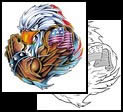 In America, soldiers from the Civil War era, through the First
and Second World Wars and Korea, Vietnam, and now Iraq, have all
acquired tattoos as an integral apart of their military experience.
Today, millions upon millions of Americans -- from active duty
military members, to reservist and war vets -- wear a tattoo as a
permanent sign of that military spirit. In America, soldiers from the Civil War era, through the First
and Second World Wars and Korea, Vietnam, and now Iraq, have all
acquired tattoos as an integral apart of their military experience.
Today, millions upon millions of Americans -- from active duty
military members, to reservist and war vets -- wear a tattoo as a
permanent sign of that military spirit.
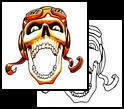 Yet, it would not be the military without regulations, and until
recently the tattoo was under strict orders not to appear on the
hands or neck. But that changed recently with a US policy revision
that reflects cultural trends -- and also allows recruitment offices
to admit more young people to the services. Three times more likely
-- that's how much more likely members of the younger generations
are to have a tattoo than their baby boomer parents. Yet, it would not be the military without regulations, and until
recently the tattoo was under strict orders not to appear on the
hands or neck. But that changed recently with a US policy revision
that reflects cultural trends -- and also allows recruitment offices
to admit more young people to the services. Three times more likely
-- that's how much more likely members of the younger generations
are to have a tattoo than their baby boomer parents.
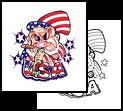 Uncle Sam may want you badly, but he still does not want you
'bad'. A prohibition remains in place against tattoos that are
extremist, indecent, racist or sexist -- anywhere on the body. 'As
long as tattoos do not distract from good military order and
discipline,' the Army has no restriction on how much of the body can
be inked. Untill recently the U.S. Coast Guard policy was twenty-five per cent, that was limit for certain body parts, like the space between the wrist
and elbow, and knee and ankle (new policy only restricts tattoo coverage above the collar of the dress uniform, and below the wrist is limited to one ring type tattoo per hand). And the Marines have recently banned
enlisted personnel from having fully tattooed arms, also known as
'sleeves'. Members who had the full tattoos were grandfathered in
under the new regulations. Uncle Sam may want you badly, but he still does not want you
'bad'. A prohibition remains in place against tattoos that are
extremist, indecent, racist or sexist -- anywhere on the body. 'As
long as tattoos do not distract from good military order and
discipline,' the Army has no restriction on how much of the body can
be inked. Untill recently the U.S. Coast Guard policy was twenty-five per cent, that was limit for certain body parts, like the space between the wrist
and elbow, and knee and ankle (new policy only restricts tattoo coverage above the collar of the dress uniform, and below the wrist is limited to one ring type tattoo per hand). And the Marines have recently banned
enlisted personnel from having fully tattooed arms, also known as
'sleeves'. Members who had the full tattoos were grandfathered in
under the new regulations.
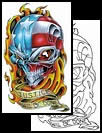 While many military tattoos commemorate a general phase of one's
life, others denote a particular military operation, often including
the date and code name. These designs are really a historical record
of events that might have dark and deadly connotations, and as such
will be more edgy. In these tattoos, we see reflected the brutal
reality of war, and we are likely to see death imagery, including
skulls. If it's true that darker and sadder emotions run deeper and
etch our characters more indelibly, then these 'battle' tattoos are
true milestones in our development as human beings. While many military tattoos commemorate a general phase of one's
life, others denote a particular military operation, often including
the date and code name. These designs are really a historical record
of events that might have dark and deadly connotations, and as such
will be more edgy. In these tattoos, we see reflected the brutal
reality of war, and we are likely to see death imagery, including
skulls. If it's true that darker and sadder emotions run deeper and
etch our characters more indelibly, then these 'battle' tattoos are
true milestones in our development as human beings.
The tattoo tradition differs among the different branches of the
American Armed Forces, with the Navy adopting it the most religiously, and
the Air Force, the least.
 The
US NAVY is synonymous with sailors and their tattoos, for
obvious historical reasons. Their long voyages to exotic lands --
and the stories and souvenirs they brought home -- continued to
amaze people worldwide, until in the early 1900's the tattoo craze
hit a peak unequalled for almost a hundred years. The anchor was and
remains the favorite motif for sailors, and as such is one of the
most popular designs, worldwide. It's was usually placed on the
upper arm, in the fashion of the The
US NAVY is synonymous with sailors and their tattoos, for
obvious historical reasons. Their long voyages to exotic lands --
and the stories and souvenirs they brought home -- continued to
amaze people worldwide, until in the early 1900's the tattoo craze
hit a peak unequalled for almost a hundred years. The anchor was and
remains the favorite motif for sailors, and as such is one of the
most popular designs, worldwide. It's was usually placed on the
upper arm, in the fashion of the
 cartoon character, Popeye. Roosters
tattooed on the foot were a common motif in the early days. They
acted as charms to protect against drowning. Christian crosses were
popular, think 'Rock of Ages', in addition to a short list of other
nautical motifs, like sailors caps, submarines and periscopes.
Images of naked women were a major hit with sailors, until the brass
issued their 'obscene' warning. After that, naval applicants could
have their hopes dashed by showing up with too much 'skin' on their
skin. Tattoo artists did a booming business tattoo grass skirts on
scantily clad hula girls. For many sailors, tattoo representations
of the ship they served on were popular. cartoon character, Popeye. Roosters
tattooed on the foot were a common motif in the early days. They
acted as charms to protect against drowning. Christian crosses were
popular, think 'Rock of Ages', in addition to a short list of other
nautical motifs, like sailors caps, submarines and periscopes.
Images of naked women were a major hit with sailors, until the brass
issued their 'obscene' warning. After that, naval applicants could
have their hopes dashed by showing up with too much 'skin' on their
skin. Tattoo artists did a booming business tattoo grass skirts on
scantily clad hula girls. For many sailors, tattoo representations
of the ship they served on were popular.

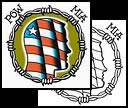 Members of the
US ARMY frequently choose eagle icons to express
their love of freedom. The flag has always been popular, also
replicas of unit patches or medals often combined with the stars and
stripes, which many soldiers take for a lifetime 'lest they forget'.
Indeed, many of these tattoos memorialize buddies who became POWs or
MIAs. The 'meat tag' tattoo is a permanent version of the dog tag,
and is often inked prior to deployment to wars or overseas missions. Members of the
US ARMY frequently choose eagle icons to express
their love of freedom. The flag has always been popular, also
replicas of unit patches or medals often combined with the stars and
stripes, which many soldiers take for a lifetime 'lest they forget'.
Indeed, many of these tattoos memorialize buddies who became POWs or
MIAs. The 'meat tag' tattoo is a permanent version of the dog tag,
and is often inked prior to deployment to wars or overseas missions.

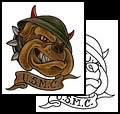 The
MARINES have traditionally been the first to hit the beach in times
of war, so they take with them all the help they can get, in terms
talismans, charms, and anything that will charge their esprit de
corps. The bulldog is a favorite symbol of the MARINES, and you
won't find many 'jarheads' without that or some other favorite
tattoo design, like a camouflage motif, or a unit patch or the
Marine Corps seal itself. The
MARINES have traditionally been the first to hit the beach in times
of war, so they take with them all the help they can get, in terms
talismans, charms, and anything that will charge their esprit de
corps. The bulldog is a favorite symbol of the MARINES, and you
won't find many 'jarheads' without that or some other favorite
tattoo design, like a camouflage motif, or a unit patch or the
Marine Corps seal itself.

 The
US AIR FORCE was the Aeronautical Division of the US Army
Signal Corps before it broke away in 1947. Being the new kids in the
barracks, pilots don't have the long tattoo tradition behind them,
but that hasn't stopped them from adopting the obvious symbolof
power and freedom, the bald eagle. National symbol and bird of prey, The
US AIR FORCE was the Aeronautical Division of the US Army
Signal Corps before it broke away in 1947. Being the new kids in the
barracks, pilots don't have the long tattoo tradition behind them,
but that hasn't stopped them from adopting the obvious symbolof
power and freedom, the bald eagle. National symbol and bird of prey,  it represents a pilot's dominion overthe wild blue yonder. Wings
are a common motif, and especially the P-51 Mustang, if you flew
during World War II. Other planes and jets serve like tattoos of
lovers, or just fond reminders, along with squadron insignias and
unit patches. it represents a pilot's dominion overthe wild blue yonder. Wings
are a common motif, and especially the P-51 Mustang, if you flew
during World War II. Other planes and jets serve like tattoos of
lovers, or just fond reminders, along with squadron insignias and
unit patches.

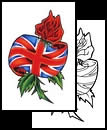 In Great Britain tattoos that featured the Union Jack, Regimental
Badges and Crest and portraits of the Royal Family have all been
popular for over a century. Tattoos of the British Bulldog, and even
portraits of Winston Churchill were popular in the Second World War. In Great Britain tattoos that featured the Union Jack, Regimental
Badges and Crest and portraits of the Royal Family have all been
popular for over a century. Tattoos of the British Bulldog, and even
portraits of Winston Churchill were popular in the Second World War.
Many of these tattoos are colorful and often cartoonish, sending
the message that one is proud to have been part of the military, and
happy to have spent a chapter of one's life in so rewarding a
career.
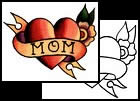 And just when you might be thinking that skulls, death's heads,
bombs, knives, daggers and other forms of armaments speak to a
culture of overwhelming machismo within the military, one must not
forget that two of the most popular tattoos in the military have
unmistakable sentimental roots. The heart tattoo with a ribbon
inscribed with Mom or Mother And just when you might be thinking that skulls, death's heads,
bombs, knives, daggers and other forms of armaments speak to a
culture of overwhelming machismo within the military, one must not
forget that two of the most popular tattoos in the military have
unmistakable sentimental roots. The heart tattoo with a ribbon
inscribed with Mom or Mother
 was and is a powerful reminder to young
soldiers of the families they have left behind and the reasons they
serve their nations. The other sentimental tattoos are the memorial
tattoos dedicated to the friends and comrades who fell in battle and
never made it home. These too, are tattoos of the heart. was and is a powerful reminder to young
soldiers of the families they have left behind and the reasons they
serve their nations. The other sentimental tattoos are the memorial
tattoos dedicated to the friends and comrades who fell in battle and
never made it home. These too, are tattoos of the heart.
See also: Memorial Tattoos,
Religious Tattoos,
Heart Tattoos,
Battlefield Cross, Uncle Sam Tattoos

Tattoo Symbol Index - A
B
C
D
E
F
G
H
I
J
K
L
M
N
O
P
Q
R
S
T
U
V
W
X
Y
Z
 |



 Like tattoos with spiritual and religious symbolism, military
tattoos often have a strong element of the amulet or talisman
connected to them. Protection in battle was often a specific
requirement of tattoos acquired in many cultures and the tattoo was
accompanied with rituals, incantations, and pigment which was
believed to have special or magical properties. Tattooing was
carried out by Shamans, medicine men, priests and other individuals
who were known to have access to special powers. These properties
might render an individual invisible or impervious to the weapons of
opponents. A tattoo in this instance was meant to act as a shield
and a final line of personal defense. This is still a belief in
places like Burma, Thailand and other areas.
Like tattoos with spiritual and religious symbolism, military
tattoos often have a strong element of the amulet or talisman
connected to them. Protection in battle was often a specific
requirement of tattoos acquired in many cultures and the tattoo was
accompanied with rituals, incantations, and pigment which was
believed to have special or magical properties. Tattooing was
carried out by Shamans, medicine men, priests and other individuals
who were known to have access to special powers. These properties
might render an individual invisible or impervious to the weapons of
opponents. A tattoo in this instance was meant to act as a shield
and a final line of personal defense. This is still a belief in
places like Burma, Thailand and other areas.  An investigation into the modern history of military tattoos
leads invariably to the South Pacific in the year 1768. We find the
English Sea Captain, James Cook commanding his first expedition in
the ship Endeavor. Cook and his crew sailed to Tahiti with a
scientific contingent to study an eclipse. Three months later they
sailed home to Europe, many of them - both Officers and ordinary
Seamen - with tattoos, a tradition among sailors that is still
practiced to this day. History cites earlier European merchant
mariners landing on Polynesian islands and witnessing with equal
astonishment the tattoo culture of the South Seas, but there's no
record of those earlier sailors bringing tattoos home as souvenirs
of their journey.
An investigation into the modern history of military tattoos
leads invariably to the South Pacific in the year 1768. We find the
English Sea Captain, James Cook commanding his first expedition in
the ship Endeavor. Cook and his crew sailed to Tahiti with a
scientific contingent to study an eclipse. Three months later they
sailed home to Europe, many of them - both Officers and ordinary
Seamen - with tattoos, a tradition among sailors that is still
practiced to this day. History cites earlier European merchant
mariners landing on Polynesian islands and witnessing with equal
astonishment the tattoo culture of the South Seas, but there's no
record of those earlier sailors bringing tattoos home as souvenirs
of their journey.





















